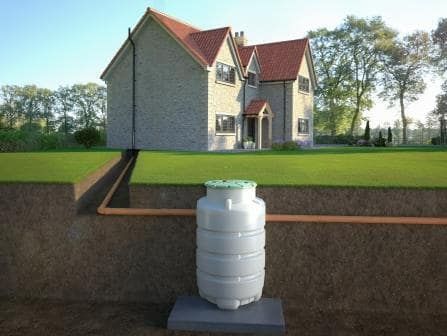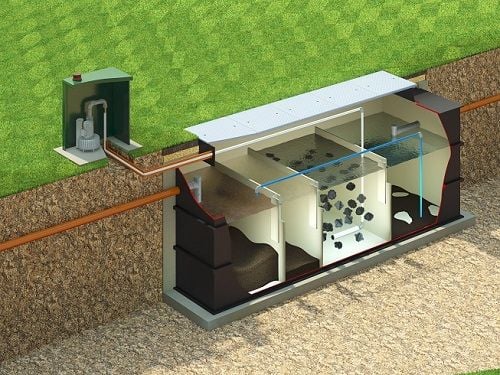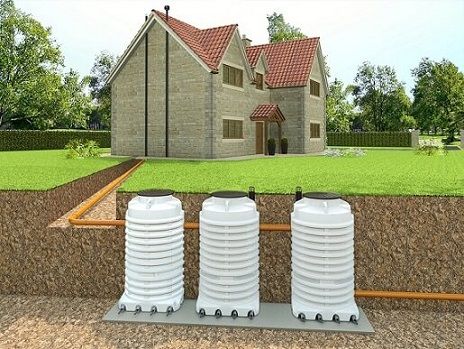Which do I need - Septic Tank or Sewage Treatment System?
Septic tanks can only discharge the septic liquid into a drainage field, as the effluent is very polluting. Sewage treatment plants have the option of discharging either to a drainage field or to a ditch, stream or other watercourse, as they clean the sewage to a much greater degree.
If you are considering using a septic tank instead of a sewage treatment plant, make sure that the ground is suitable for a foul water soakaway drainage field, as over 70% of UK sites fail the mandatory tests that allow them to be installed or replaced. Either the Soakaway Trial Site Assessment Hole, (to find out the highest level of the water table), or the Percolation Tests, (to find out how porous the soil is), fail these tests.
Most modern properties also don't own enough land to enable a soakaway drainage field to be installed. You need a VERY large lawn area for a soakaway drainage field.
When you install a sewage treatment plant, the Soakaway Drainage Field size required is reduced by 20%, which may outweigh the additional cost of the Sewage Treatment Plant.
The installation cost of a sewage plant is also no more expensive than that of a septic tank as the plant is smaller.
However, If your single property is within 30 metres of a possible public sewer connection, then you must connect to it and cannot have either a septic tank or sewage treatment plant. This is the case even if the levels do not match up as you must then use a pumping station to lift the final effluent to the correct level to discharge into the mains sewer system.
If you are discharging from more than one property, multiply the number of houses by 30 metres.
Example If there are 3 properties then this will give you a distance of 90 metres to the mains sewer (3 × 30 metres).
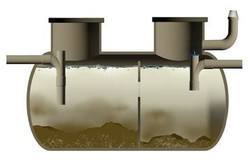
Septic Tanks
Septic tanks were the old traditional method of treating sewage where no mains connection was possible. However, changing regulations have made them unviable for most areas in the UK now, as the drainage field area soil must pass tests and the land area required is bigger than most people own.
They contain 1, 2 or 3 chambers which separate solids from liquids and fats. Fats float to the surface of the first chamber and solidify, whilst heavy solids sink to the bottom. The middle liquid layer then flows into the second chamber, where further separation occurs and the middle liquid layer flows out into a drainage field.
These drainage fields occupy a large area, up to 250 square metres for a 4 bedroom house, even if your land is suitable and passes the Percolation Tests. The bigger the development, the worse this problem becomes, as the drainage field area increases accordingly.
Septic tank - Factors To Consider
- Only separates solid and liquid waste, but does not treat it.
- 70% of sites will fail the regulations that allow septic tanks to be installed.
- The liquid waste is very polluting to the soil and will kill any earthworms it touches.
- Requires regular emptying - at least once a year.
- Is not allowed to discharge into any watercourse, even by accident.
- More expensive to install than a sewage treatment plant which discharges to a watercourse.
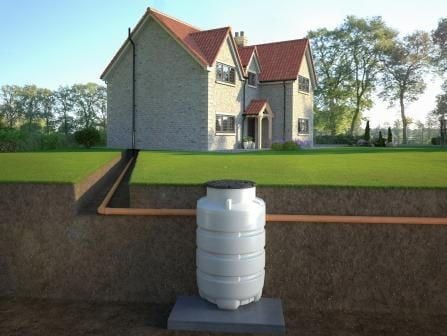
Sewage Treatment Plants
Sewage treatment plants are the modern method of treating sewage where no mains connection is possible.
Domestic sewage treatment plants contain 1, 2 or 3 chambers, which separate solids from liquids, digest the pollutants and make the resulting effluent clean enough to be discharged into a stream, river or ditch with flowing water in it.
There are various designs, but they all achieve the same thing - clean effluent.
If you don't have a watercourse available, they can still use a drainage field, but the drainage field will be 20% smaller than that needed for a septic tank.
However, the same soil testing is required as for septic tank drainage fields.
Sewage treatment plants - Factors To Consider
- They digest the pollutants in the liquid part of the sewage and some also digest up to 98% of the solids as well.
- They can discharge directly to watercourses.
- The liquid waste is not polluting to the soil and will not kill any earthworms it touches.
- Requires emptying on a regular basis - depending on the make, every 6 to 12 months on average.
- Less expensive to install than a septic tank and drainage field.
Septic Tank and Sewage Treatment Plant Regulations
The Environment gency introduced new rules for wastewater under their 'General Binding Rules' in 2020.
Septic tank discharges to water were made illegal. Any septic tank that does discharge to a ditch or steam has to either connect to a mains sewer - if possible - or be replaced by a sewage treatment plant, or discharge to a drainage field, with full Building Regulation approval.
Please ring us for answers to any questions you may have.
It is far cheaper and easier to replace it with a sewage treatment plant

